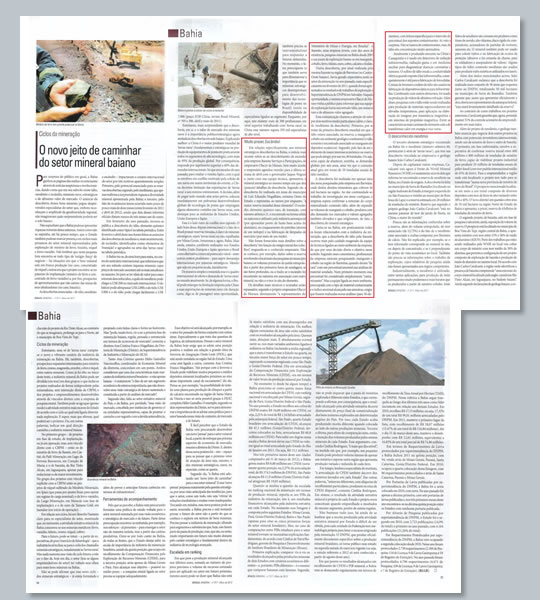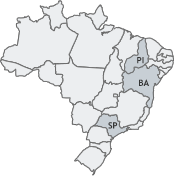
Pleased to meet you, Scandium!
Specifically in relation to the strategic minerals discovered in Bahia, the most recent news refer to the Discovery of Scandium by the company Itaoeste Serviços e Participações, owned by businessman Olacyr de Moraes. Without great fuss, the businessman scheduled a meeting for the last week of April with Governor Jaques Wagner and, with his technical team, introduced the strategic ore, at the same time in which he described (few) details of the discovery. According to him, the discovery occurred in areas of the Municipality of Luís Eduardo Magalhães, West edge of the State, and represents at least for the time being, “the largest worldwide deposit of such element". Scandium, a rare transition chemical element with atomic number 21, is found in its solid form in nature and used by the aero spatial industry (because it has a melting point well above aluminum), in the cracking of oil (by means of an isotope) and in the manufacture of mercury lamps (by means of an oxide).
No more details were provided on the discovery “as a consequence of the initial stage of the work”, safeguards the well-known businessman. One does not know, for instance, data on the reserve involving the exact site of the prospecting in the Bahia municipality; the primary volumes of the mine, projected as of the first sounding drillings; if they are deep drillings or trado, if the scandium was found in nature associated to other mineral or not; and the in situ tenor of the element.
The more technical and accurate details will be conveyed, according to businessman Olacyr de Moraes, directly to “representatives of the Ministry of Mines and Energy, in Brasilia”. Itaoeste, a young company, with ten years existence, prospects minerals in Bahia since 2005 and its exploitation program is based in Manganese, Cobalt, Iron, Titanium, Gold, Copper, Limestone and Phosphide.
Another discovery, by the way also made by Itaoeste in the Barreiras region (in Bahia’s Center-West), had generated expectations in the mining area last year, more specifically in February 2011, when the results of the prospection work were submitted to the DNPM Superintendence in Salvador. At that time, the same businessman, Olacyr de Moraes came to the public to inform that its prospection team had found Thallium, a rare mineral of extremely high added value.
Such communication called the attention of the area due to two very special reasons (in addition, naturally, to the originality of the discovery). In first place, being the first worldwide discovery associated to Thallium, in the reserve, to Manganese and Cobalt in continental geological environment (Thallium is only found associated to Manganese in Oceanic deposits). In second place, due to being an element of main economic interest in the reserve, which may achieve, on its side, 60 tons. That is, would be able to supply, alone, the global demands for six years, since the current consumption is around 10 tons per year of metallic Thallium.
The Discovery was made in only one of the areas prospected by the company in Barreiras, where it has mining rights covering 44 thousand hectares in the area. By continuing the investigation work in neighboring areas, the company expects to confirm the extension of the mineral veins containing Thallium, in addition to expanding the volumes of Manganese and Cobalt, products with high demand in the markets and high added values, and which originate, in fact, the discovery of the strategic mineral.
It is said in Bahia, in practically all places related to the mining industry, that the discovery of Thallium by Itaoeste occurred more due to the extreme care of the team of company’s technicians related to the environment than due to a direct and objective decision in such sense. According to such comments, company’s professional were prospecting Manganese and Cobalt in the Barreiras region, when they “bumped into” an abnormal percentage in the analysis of the soundings material. In a first moment, such percentage was simply considered “contamination”. However, the environment team, concerned with the kind of contamination and the abnormal rate achieved in the samples, demanded new analysis (for 36 elements), with specific reading for the perceptual interval of the purported contaminations, and there came the surprise. It was not contamination, but Thallium in extremely encouraging concentration.
Currently, Thallium is only produced in China and Kazakhstan and is used in infrared radiation detectors, gamma radiation and in nuclear medicine for the diagnosis of coronaries diseases and tumors. The Thallium Sulphide changes the electrical conductivity when exposed to infrared light, consequently it is useful in the manufacture of photocells. Bromide crystals and Thallium Iodate are used to manufacture optical devices for infrared. Combined to other elements, it was used to produce glass with extremely high refraction. Additionally, Thallium researches are being conducted to produce superconducting material at high temperatures, to be applied in the preparation of images by magnetic resonance and in magnetic propulsion systems. Among the most curious characteristics of the element, it can convert heat into energy and vice-versa.

Rua Fidêncio Ramos, 160 – 2º andar – sala 211 – CEP: 04551-010 - Vila Olímpia – São Paulo - SP
Tel: (11) 3168-3705 | contato@itaoeste.com.br


